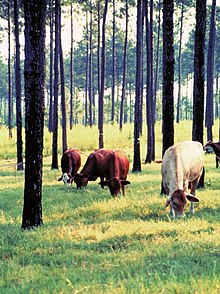
Back Silvopastura Catalan Lesní pastva Czech Hutewald German Sistemas silvopastoriles Spanish جنگل مرتعی Persian Sylvopastoralisme French Wanagembala ID Silvopasture IG Silvopastorizia Italian Sistema silvipastoril Portuguese
It has been suggested that this article be merged with Dehesa, Forest gardening, Forest farming, Syntropic agriculture, Inga alley cropping, Farmer-managed natural regeneration and Kuojtakiloyan to Agroforestry. (Discuss) Proposed since May 2024. |

Silvopasture (silva is forest in Latin) is the practice of integrating trees, forage, and the grazing of domesticated animals in a mutually beneficial way.[1] It utilizes the principles of managed grazing, and it is one of several distinct forms of agroforestry.[2]
Properly managed silvopasture (grazed woodland) can increase overall productivity and long-term income due to the simultaneous production of tree crops, forage, and livestock, and can provide environmental benefits and has been practiced in many parts of the world for centuries. Silvopasture is not the same as unmanaged grazing in woodlands.
- ^ Gabriel, Steve (2018). Silvopasture : a guide to managing grazing animals, forage crops, and trees in a temperate farm ecosystem. White River Junction, Vermont. ISBN 9781603587310. OCLC 1020304962.
{{cite book}}: CS1 maint: location missing publisher (link) - ^ Wilson, Matthew; Lovell, Sarah (2016-06-18). "Agroforestry—The Next Step in Sustainable and Resilient Agriculture". Sustainability. 8 (6): 574. doi:10.3390/su8060574. ISSN 2071-1050.
© MMXXIII Rich X Search. We shall prevail. All rights reserved. Rich X Search